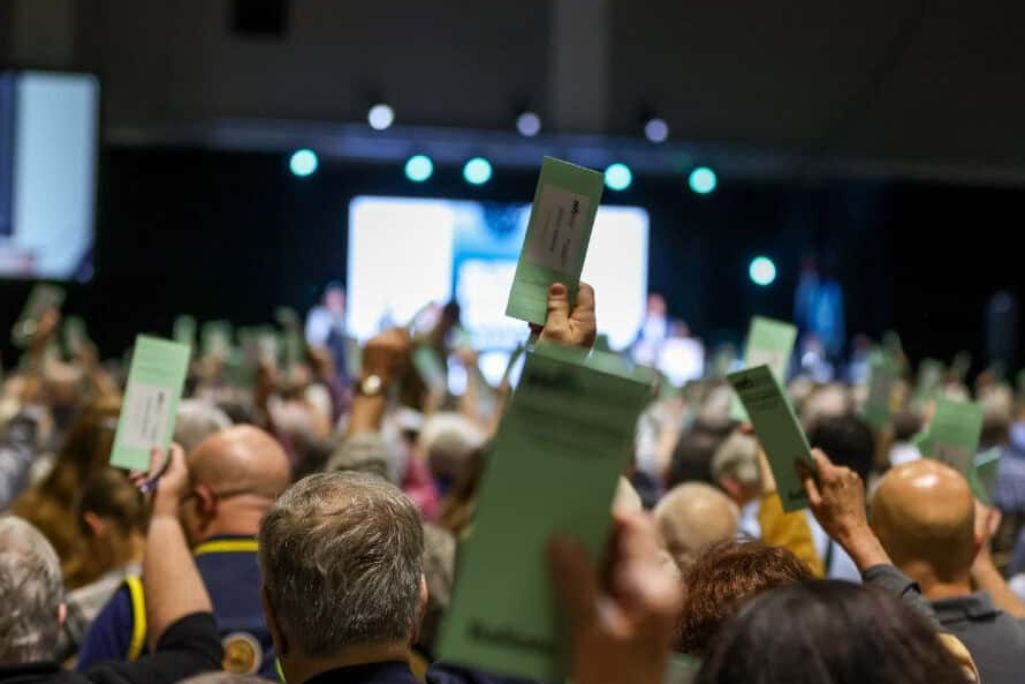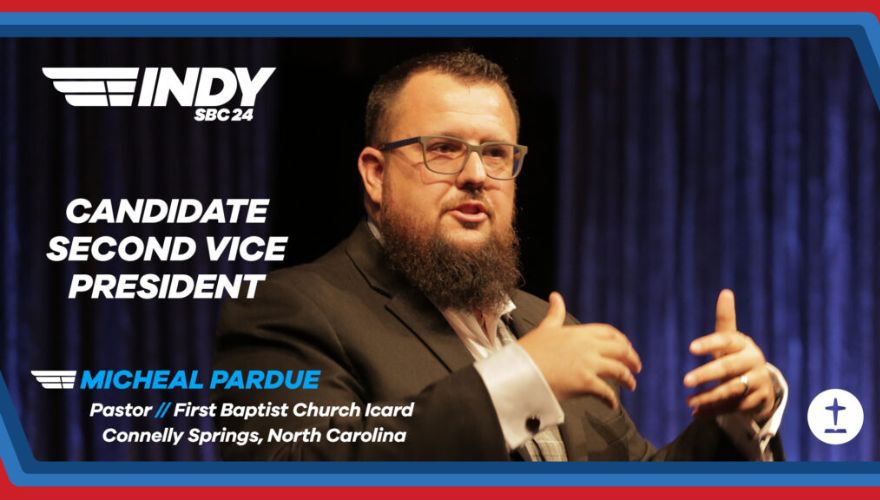
At their 2024 annual meeting in October, Missouri Baptists adopted an unchanged budget of $15 million and an unchanged allocation to national CP of 40%.
NASHVILLE (BP) — The Cooperative Program (CP) stands at a crossroads as its 100th birthday approaches.
Messengers to the Tennessee Baptist Convention’s Summit felt that reality this fall. They voted reluctantly to decrease the Southern Baptist Convention (SBC) percentage of the Tennessee convention’s CP allocation from 47.5% to 45% and retain 55% for Tennessee ministries.
“When we started moving toward 50/50 distribution of Cooperative Program giving, that was overwhelmingly approved by our messengers,” said Randy Davis, president of the Tennessee Baptist Mission Board (TBMB). But CP “giving over the past decade has remained flat” in Tennessee. “When you couple that with an inflation rate over the last decade of 24%, you can see the dilemma we’re in” to fund Tennessee ministries.
Originally, the TBMB recommended allocating 40% of the 2025 CP budget for SBC causes, 55% for Tennessee ministries and 5% directly to the International Mission Board (IMB). The proposal was intended to funnel the same percentage of CP dollars to the IMB that it would have received through a 50/50 split of receipts. But Tennessee messengers amended the distribution to a straight 45/55 split over fears that giving 5% directly to IMB would hurt other SBC entities by decreasing their allocations.
Tennessee isn’t the only state Baptist convention facing a funding dilemma. Multiple state and regional conventions this fall sought to cope with a stark reality: They cannot keep giving more to SBC causes when they are receiving less from churches.
“Giving to the Cooperative Program is impacted by many factors — including economic pressures on churches and conventions — as well as competing funding requests from many other Christian organizations,” said Jeff Iorg, president of the SBC Executive Committee. “Southern Baptists still believe in cooperation, and a new generation must decide how to prioritize Cooperative Program giving to assure the long-term stability and fiscal health of our global efforts.”
Budget cuts
CP is Southern Baptists’ unified mechanism for funding missions and ministries in North America and around the world. A local church gives through CP by sending money to its state Baptist convention. That convention, in turn, decides a percentage of CP receipts to use for in-state ministries and a percentage to forward to the Executive Committee for distribution among SBC causes.
All appears well with CP when considering funds forwarded from state conventions to the SBC. Twenty years ago, state conventions forwarded $175.5 million to SBC ministries. Ten years ago, the figure climbed to $183.4 million. For 2022-23, the most recent year for which complete statistics are available, it was $187.4 million.
But state conventions have been forwarding more money to the SBC even as they receive less from churches. Twenty years ago, churches gave a total of just over $501 million through CP. It dropped to $482 million 10 years ago and $449 million last year. The bottom line: State conventions forwarded $12 million more to CP last year than they did two decades ago even though they received $52 million less.
Southern Baptist leaders have wondered for years how long that trajectory can be sustained. For some state conventions, the answer is not any longer.
The California Southern Baptist Convention (CSBC) voted this fall to restructure its formula for distributing CP funds. The convention adopted an in-state CP budget of $3.85 million and a “CP gifts objective” of $5 million. That means from the first $5 million given through CP next year, 2% will go to California Baptist University, 1% to the Baptist Foundation of California and $3.85 million will be used for budgeted California ministries. The rest will go to SBC causes. All CP receipts over $5 million will go fully to SBC causes.
If California CP receipts come in at $5 million, that would mean 20% forwarded to SBC causes. CP receipts of $5.2 million would mean 25% to SBC causes, and $5.4 million in receipts would mean 30% to SBC causes. The CSBC’s 2024 budget of $6 million allocated 35% to SBC causes.
As CP receipts from churches decreased from $5.85 million in 2022 to a projected $5.1 million this year, “we have been doing budget cuts and cutting staff,” CSBC Executive Director Pete Ramirez said. “Our executive board had been discussing this new [CP] formula for a couple of years. They finally said, ‘We don’t want you to continue to be cutting staff. We want you to be able to continue to do the ministry in California.’”
Leaders of SBC entities have been sympathetic about the CSBC budget adjustment, Ramirez said, because everyone understands the real challenge of CP is inspiring churches to give more.
“We are at a crossroads where the Cooperative Program might not be what it was in the past,” Ramirez said, adding, “The way this younger generation gives to missions is different than the previous generations. We’re going to have to figure out how do we do things different in our states to continue to do the great work we do as Southern Baptists.”
‘We remain confident’
California was one of six state and regional conventions this fall that decreased the percentage of CP receipts allocated to SBC causes. Five state conventions increased their percentage to SBC causes, with the biggest jumps coming in at 1% in Indiana and the Baptist Resource Network of Pennsylvania-South Jersey. Twenty-seven conventions kept their SBC allocations the same.
Two state conventions (the Baptist General Convention of Texas and the Baptist General Association of Virginia) offer churches various giving plans for supporting out-of-state ministries, with CP being among the options.
Ten years ago, the picture was very different. In 2014, 23 state conventions increased their percentage of CP receipts to SBC causes.
Nevada was among the states to reduce its SBC allocation this fall, going from 50% in 2024 to 25% in 2025. But Nevada Baptists have a plan to boost giving from local churches and money forwarded to SBC missions and ministries.
“We had a 10-year stint of being a 50/50 state and were proud of that,” said Damian Cirincione, executive director of the Nevada Baptist Convention. But when he assumed his current role three years ago, “we had already been operating in a deficit and pulling out of reserves.”
The 75/25 allocation adopted this year will both fund increased efforts to assist Nevada churches and facilitate the work of a task force to strengthen CP giving. About five years ago, transitions at the state convention and in local churches resulted in hundreds of thousands fewer dollars coming into Nevada CP. Cirincione is optimistic giving can increase again.
“Though we’ve had to pivot slightly, we remain confident,” he said, noting that Nevada Baptists continue to enjoy a warm relationship with all the SBC entities. “We are working with our churches to build out a strategy that will strengthen our giving in the coming days and our generosity in our contributions to CP as we engage and educate.”
‘Cast a vision’
For state convention leaders, the present state of CP giving marks an opportunity rather than a discouragement. Over the past 20 years, undesignated giving to Southern Baptist churches has increased by nearly $3 billion, according to SBC Annuals. That’s a huge pool of potential money that could be given through CP.
“We must cast a vision for what’s needed and the difference 2 or 3% could make in Cooperative Program giving,” Davis said.
Iorg agrees. As he attended more than a dozen state convention annual meetings this fall, he witnessed an enthusiasm for Southern Baptist ministries that stands ready to be channeled into CP giving.
“My core message has been ‘Southern Baptists are a force for good,’” Iorg said, “and the response to that message has been very positive, including standing ovations in a few places, which was more about resonating with the message than applauding my presentation.”
(EDITOR’S NOTE — David Roach is a writer in Mobile, Ala.)


